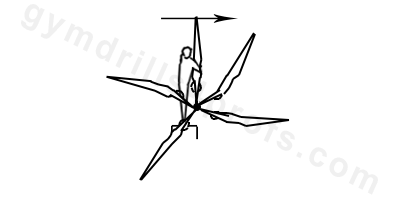


The giant starts from a handstand. The gymnast is in a slight hollow position. Extending their body from the shoulders down to the bottom. At the bottom of the rotation, they should do a tap swing. If the gymnast wants to accelerate the giant, he/she should perform the tap swing from the bottom and afterward. A later tap yields faster acceleration. During the execution of a regular giant (after the tap swing), the gymnast continues the upward rotation in a hollow position. Simply said the only place in which there is a change in the position of the body is the lower vertical (during the tap performance). In case of acceleration, after the bottom, the gymnast should cut their shoulder angle slightly and aggressively kick upward with their legs from their feet. The body should be in a hollow to a slightly piked position. The giant finishes in a handstand.

The most essential skill on high bar is the swing. Almost every skill on this apparatus consists of a front of backswing. That’s why it’s critical for a gymnast’s future to be able to execute a proper swing. The skill starts at the highest point of the backswing. The gymnast should be in a hollow body position with their head neutral. At the bottom of the swing, the gymnast should arch slightly, making a whip. They should then return to the hollow position in the front swing. There are modifications of the tap swing. For example, in a flyaway, the tap should be prior to reaching suspension. If the gymnast needs to accelerate the swing for a giant, the tap may be slightly after the suspension. After the tap, the gymnast’s body should continue in hollow until the top of the swing. After this follows the back swing. Until the bottom of the back swing the body should be exactly tight. After the suspension, the gymnast begins to hollow and become slightly piked while they shift their wrists. This prevents them from slipping off while regrasping. The back swing finishes at the very top of the move in the hollow position.

The gymnast accelerates the swings with an aggressive tap and repeats them with higher and higher amplitude until the backswing reaches the handstand. In the rotation down, the body is in a slight hollow position. The athlete extends their shoulders and performs a long downswing until the bottom. Before the lower vertical position, initiate the tap swing and finish it right after the vertical. In the upswing, the gymnast may cut the swing with an angle of the shoulders. The body continues this shape in a hollow position. Finish in a handstand.

The gymnast accelerates the swings with an aggressive tap and repeats them with higher and higher amplitude until the front swing reaches the handstand. In the backswing down, the body is in an exact straight position. The athlete extends their shoulders with the head in a neutral position and performs a long downswing until the bottom. From the bottom initiate piking from the hips. The shoulder angle should be clean. As the upper body reaches the upper vertical, the gymnast raises their legs, cleans the angles form their hips and finishes the swing at the handstand in a hollow position.

The gymnast’s body should be in a hollow position. This skill should be performed on the floor. The gymnast should turn their hands inward with their fingertips facing one another. They should reach to touch their toes, palms flexed and flat. They should extend to their tippy toes, keep their chin down, and roll backward with straight legs. From the hollow position on the floor, they should raise their toes to the ceiling and reach their arms behind their head. The gymnast’s arms should stay straight for the entire duration of the skill, catching themselves on their palms. The gymnast should stay hollow and point their toes over their head, landing in a piked / hollow body.

The gymnast accelerates the swings with an aggressive tap and repeats them with higher and higher amplitude until the backswing reaches a handstand position. This is an indication that the athlete is capable to move on to giants. The gymnast performs giants and when they reach the handstand the coach should spot him/her. It helps the gymnast to correct the body position and to feel better about reaching the handstand.

This drill is similar to the previous one (back giant with straps). The gymnast performs the giants with sneakers. It helps to increase the power from the tap swing.

The gymnast initiates the skill from support on the bar. The coach assists with the cast handstand. Also, the coach corrects the position of the handstand if its necessary. The gymnast performs the giant and the coach holds them at the end of the skill at handstand, or assists in reaching the handstand.
Integral part of gymnastics coaching process are skill drills. They help gymnasts to learn easier and technically correct. With GYM DRILL PRO you will find variety of ideas for the most the basic gymnastics skills. There are plenty of images with skill drill progressions. It is intended to support explicitly the qualified coaches in their daily coaching business. DO NOT practice without the guidance of proper professionals.